The story of a unique narrow gauge 2-4-4-2 Mallet

The
Master Mechanics of the Allegheny Valley Railroad Company have always
been, if nothing else, very resourceful. They had to be, or the
railroad - and their jobs - might not make it into the next quarter. In
early May of 1917 Master Mechanic Daniel St.Clair keenly felt the
pressure. War had been declared with Germany the month before, bringing
with it an increased demand for raw materials,. The coal and oil fields
along the line were answering the call to duty. And so were many of his
best young men. In the old days, if there was heavy tonnage to
move, the railroad simply assigned a helper, or ran an extra train.
Some of the old timers had volunteered to come out of retirement, but
Master St.Clair knew that if the railroad was to keep pace with the
needs of a nation at war, it would need heavier locomotives to move
more freight with fewer men, and soon.
Enquiries to several used locomotive dealers revealed that there was simply nothing to be had at any price. Especially in the way of larger 42" gauge locomotives, and more importantly at a price the company could afford to pay. The only thing available was a pair of worn out ancient 0-4-2 Dinkies, not even from the same builders. Totally useless for the AV's needs..... or were they? Master St. Clair remembered reading that Baldwin had built a pair of 2-4-4-2 Mallets for a logging company in Tennesee some years earlier. They were about the same size, could something similar be the answer to his dilemma?
Master St.Clair knew something had to be done. There was simply no alternative, and failure was not a option. He'd sooner be back starving on a tenant farm in Ireland! So he carefully made his sketches, and presented the plan to company President Charles Burr. The resulting engine would be something of a mongrel, but well within the company's financial means. The frame was to be made in-house, the mechanicals rebuilt from the Dinkies, and a suitable boiler purchased from a builder in Philadelphia. It was a great relief when Mr. Burr gave his tenative approval.
Working late into the night, often by candlelight, Master St. Clair had the final drawings completed by late July. Approval came quickly, but the needed materials did not. It was well into March of 1918 before work on the chassis was completed, and the boiler was not delivered until June! Finally, on September 22, 1918 the Allegheny Valley's brand new Mallet rolled out of the shop, paint sparkling in the bright autumn sun. On her sides she proudly bore #8, and the name 'Loyal E. Burr' - the name of the AV President's newborn son.
To say that the new locomotive met with rousing success would be a blatant lie. The 8-spot or 'Little Chuck', as she was sometimes called - at least when management could hear, was universally hated by the engine crews. Her un-equalized chassis rode rough, much like the Dinkies she was built from. Her long narrow firebox made her very hard to fire, and she was notoriously slippery - with one engine set or the other often spinning with little notice. The proud maintenance crew who had so lovingly built her soon learned to dislike her as well. Not only were there twice as many moving parts to maintain as a similar sized Consolidation, the engine crews showed their intense dislike for her by 'accidentally' damaging things. The little Mallet was quickly gaining the reputation as a 'shop queen'
November 1918 brought Armistice. The war to end all wars was over, and traffic level along the line returned to pre-war levels almost as fast as they had risen. And #8, so recently born from necessity, was now pretty much surplus. Yet, perhaps because of the name, the company never quite got around to selling her. The 8-spot saw occasional service throughout the '20s, but most traffic was more ably handled by the older Consolidations. Master St Clair still had a soft spot for his creation, and tried - as he was able - to find ways to improve her performance. During slack time her chassis was upgraded with equalizers from a wrecked Consolidation. Well tanks were added between the frame rails and filled with scrap tie plates other odd junk to try to reduce the slipping problem. And a raised tender deck was tried to see if that would ease the fireman's burdens. These changes all helped improve the little Mallet's performance, but not enough to overcome the operating department's dislike of her.
The great depression and increases in truck traffic nearly brought an end to the Allegheny Valley, and with it the unloved #8. Yet, much as she was now completely unneeded, she was worth even less as scrap. The little Mallet spent much of the decade languishing behind the shop where she was built. Our story might have ended there, but for a curious twist of fate. War once more, as it had done a generation before, reared it's ugly head in Europe. New immigrants brought tales of a terrible man called Hitler, and his Blitzkreig. Lend-Lease with England once again brought increased traffic to the AV, staving off receivership. And 'Little Chuck' was towed into the shop to see if she could be made servicable to sell abroad. After all, South Africa had many 42" gauge lines, as did many parts of the British Empire in Asia.
Once more operable, but lacking a buyer, #8 was reluctantly placed back into coal drag service on the Allegheny Valley after Pearl Harbor. She was assigned to the least senior crew, a young German refugee engineer named Karl Brandstetter, and a brawny Irish fireman with the very English sounding name of Harry Allen. The two were inseperable friends, known almost as much for their love of brawling as their almost uncanny ability to get the most out of whatever piece of junk the railroad gave them. It was a match made in heaven, or at least a repreive for 'Little Chuck', who's namesake was now Vice President of Operations.. "She's much nicer to me zan the Nazis were! Ja?" is what Karl would say of #8 when asked. Even a long walk in the snow after hitting an elk and derailing near Emlenton in the winter of 1943 didn't diminish the crew's growing fondness for their cantankerous charge. They promptly mounted the antlers atop the headlight, and laughingly proclaimed "Only four more, and we'll be Aces!"
All things must end. The end of the war saw once again saw a reversal in fortune on the AV. The coal seams that had seen the nation through two world wars were nearly exhausted. Oil from Texas and Oklahoma proved to be less costly than that from the once great Pennsylvania fields. And trucks took more and more of the little remaining freight revenue from the railroad's coffers. The rich city dwellers now preferred to drive to their vacation homes along the river. Even Karl and Harry moved on to better paying jobs with other railroads.. The Allegheny Valley bravely soldiered on into the 1950's, still running steam when everyone else had gone to diesel - mostly because they couldn't afford to upgrade anything, or even perform much in the way of maintenance. The little Mallet once again sat quietly rusting away in the dead line behind the shop, in exactly the same spot where she had spent so many years two decades before. She seemed once again doomed meet the scrapper's torch.
Yet fate, ever fickle, stepped in once more with yet another surprise in store. Stories of the odd little 'homemade' locomotive began to make the rounds of newly formed railfan groups throughout the Northeast. People actually started to come to Western Pennsylvania and the Allegheny Valley to see narrow gauge trains pulled by obsolete steam engines, and to take pictures of the forlorn 8-spot! The management company, at first annoyed, soon became intriqued by the increasing number of people showing up on their property with cameras. Other shortlines and narrow gauge railroads had started offering something called 'tourist service' and 'fan trips' - very much like the local picnic trains at the turn of the century. Why wouldn't it work for the AV? But they needed something unique to set them apart. So why not old #8? Once more the little Mallet was towed into the old shop. It was determined that the old 8-spot could indeed be returned to operation with very little rebuilding - Her lack use for all those years was actually working in her favor! And on Memorial Day 1958, the weird unearthly banshee call of her shop built 6-chime whistle once again echoed across the hills of the Allegheny Valley.
OK, that's the romantic, but very made up story. In reality the Allegheny Valley Railroad was never narrow gauge. It was also absorbed by the Pennsylvania Railroad in the teens. Still, I fell in love the locales and the name over a decade ago. And when I became interested in large scale, most of what was available inexpensively was second hand narrow gauge. So why not combine both?
First of all, yes there really were a handful of 2-4-4-2 Mallets built by Baldwin. The first was in June of 1909 for the Little River Railroad and Lumber Co in Townsend Tennessee as their #126. This locomotive was the inspiration for my build.
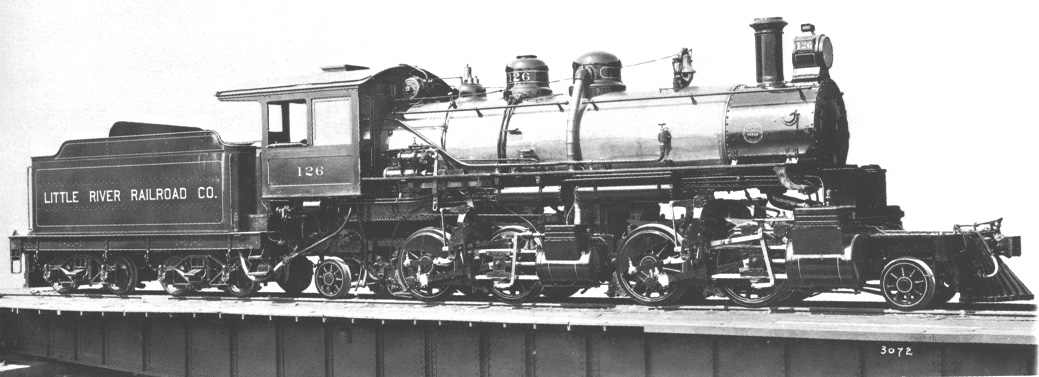
Much like in the story, the #8 started out as a pair of used Dinkies. I used the motor blocks and cylinders from a 20 year old LGB 2017, and a similar vintage 2020. These were 0-4-0s not 0-4-2s as stated in the story, but I needed a plausible source for the pilot and trailing trucks.
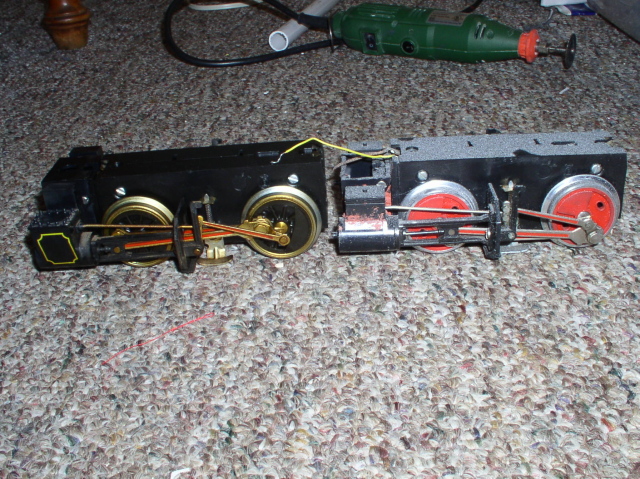
The boiler and much of the superstructure were constructed from new-old-stock Delton C-16 (2-8-0) parts. Many, many small detail castings were purchased from Ozark Miniatures and Trackside Details.
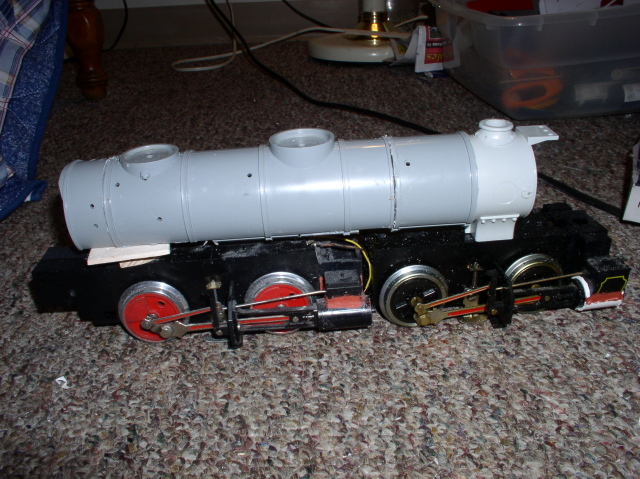
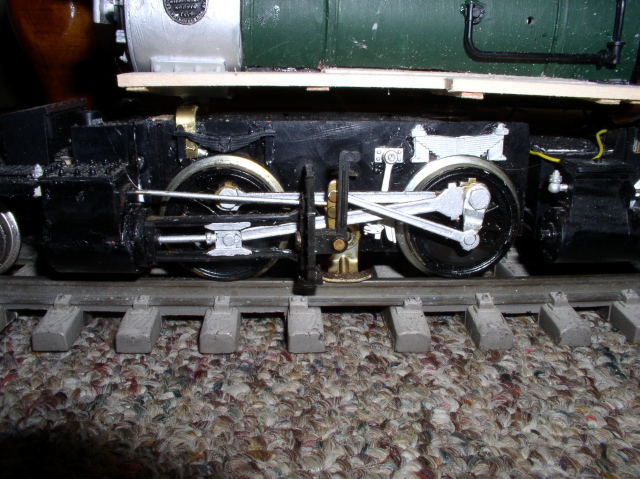
Enquiries to several used locomotive dealers revealed that there was simply nothing to be had at any price. Especially in the way of larger 42" gauge locomotives, and more importantly at a price the company could afford to pay. The only thing available was a pair of worn out ancient 0-4-2 Dinkies, not even from the same builders. Totally useless for the AV's needs..... or were they? Master St. Clair remembered reading that Baldwin had built a pair of 2-4-4-2 Mallets for a logging company in Tennesee some years earlier. They were about the same size, could something similar be the answer to his dilemma?
Master St.Clair knew something had to be done. There was simply no alternative, and failure was not a option. He'd sooner be back starving on a tenant farm in Ireland! So he carefully made his sketches, and presented the plan to company President Charles Burr. The resulting engine would be something of a mongrel, but well within the company's financial means. The frame was to be made in-house, the mechanicals rebuilt from the Dinkies, and a suitable boiler purchased from a builder in Philadelphia. It was a great relief when Mr. Burr gave his tenative approval.
Working late into the night, often by candlelight, Master St. Clair had the final drawings completed by late July. Approval came quickly, but the needed materials did not. It was well into March of 1918 before work on the chassis was completed, and the boiler was not delivered until June! Finally, on September 22, 1918 the Allegheny Valley's brand new Mallet rolled out of the shop, paint sparkling in the bright autumn sun. On her sides she proudly bore #8, and the name 'Loyal E. Burr' - the name of the AV President's newborn son.
To say that the new locomotive met with rousing success would be a blatant lie. The 8-spot or 'Little Chuck', as she was sometimes called - at least when management could hear, was universally hated by the engine crews. Her un-equalized chassis rode rough, much like the Dinkies she was built from. Her long narrow firebox made her very hard to fire, and she was notoriously slippery - with one engine set or the other often spinning with little notice. The proud maintenance crew who had so lovingly built her soon learned to dislike her as well. Not only were there twice as many moving parts to maintain as a similar sized Consolidation, the engine crews showed their intense dislike for her by 'accidentally' damaging things. The little Mallet was quickly gaining the reputation as a 'shop queen'
November 1918 brought Armistice. The war to end all wars was over, and traffic level along the line returned to pre-war levels almost as fast as they had risen. And #8, so recently born from necessity, was now pretty much surplus. Yet, perhaps because of the name, the company never quite got around to selling her. The 8-spot saw occasional service throughout the '20s, but most traffic was more ably handled by the older Consolidations. Master St Clair still had a soft spot for his creation, and tried - as he was able - to find ways to improve her performance. During slack time her chassis was upgraded with equalizers from a wrecked Consolidation. Well tanks were added between the frame rails and filled with scrap tie plates other odd junk to try to reduce the slipping problem. And a raised tender deck was tried to see if that would ease the fireman's burdens. These changes all helped improve the little Mallet's performance, but not enough to overcome the operating department's dislike of her.
The great depression and increases in truck traffic nearly brought an end to the Allegheny Valley, and with it the unloved #8. Yet, much as she was now completely unneeded, she was worth even less as scrap. The little Mallet spent much of the decade languishing behind the shop where she was built. Our story might have ended there, but for a curious twist of fate. War once more, as it had done a generation before, reared it's ugly head in Europe. New immigrants brought tales of a terrible man called Hitler, and his Blitzkreig. Lend-Lease with England once again brought increased traffic to the AV, staving off receivership. And 'Little Chuck' was towed into the shop to see if she could be made servicable to sell abroad. After all, South Africa had many 42" gauge lines, as did many parts of the British Empire in Asia.
Once more operable, but lacking a buyer, #8 was reluctantly placed back into coal drag service on the Allegheny Valley after Pearl Harbor. She was assigned to the least senior crew, a young German refugee engineer named Karl Brandstetter, and a brawny Irish fireman with the very English sounding name of Harry Allen. The two were inseperable friends, known almost as much for their love of brawling as their almost uncanny ability to get the most out of whatever piece of junk the railroad gave them. It was a match made in heaven, or at least a repreive for 'Little Chuck', who's namesake was now Vice President of Operations.. "She's much nicer to me zan the Nazis were! Ja?" is what Karl would say of #8 when asked. Even a long walk in the snow after hitting an elk and derailing near Emlenton in the winter of 1943 didn't diminish the crew's growing fondness for their cantankerous charge. They promptly mounted the antlers atop the headlight, and laughingly proclaimed "Only four more, and we'll be Aces!"
All things must end. The end of the war saw once again saw a reversal in fortune on the AV. The coal seams that had seen the nation through two world wars were nearly exhausted. Oil from Texas and Oklahoma proved to be less costly than that from the once great Pennsylvania fields. And trucks took more and more of the little remaining freight revenue from the railroad's coffers. The rich city dwellers now preferred to drive to their vacation homes along the river. Even Karl and Harry moved on to better paying jobs with other railroads.. The Allegheny Valley bravely soldiered on into the 1950's, still running steam when everyone else had gone to diesel - mostly because they couldn't afford to upgrade anything, or even perform much in the way of maintenance. The little Mallet once again sat quietly rusting away in the dead line behind the shop, in exactly the same spot where she had spent so many years two decades before. She seemed once again doomed meet the scrapper's torch.
Yet fate, ever fickle, stepped in once more with yet another surprise in store. Stories of the odd little 'homemade' locomotive began to make the rounds of newly formed railfan groups throughout the Northeast. People actually started to come to Western Pennsylvania and the Allegheny Valley to see narrow gauge trains pulled by obsolete steam engines, and to take pictures of the forlorn 8-spot! The management company, at first annoyed, soon became intriqued by the increasing number of people showing up on their property with cameras. Other shortlines and narrow gauge railroads had started offering something called 'tourist service' and 'fan trips' - very much like the local picnic trains at the turn of the century. Why wouldn't it work for the AV? But they needed something unique to set them apart. So why not old #8? Once more the little Mallet was towed into the old shop. It was determined that the old 8-spot could indeed be returned to operation with very little rebuilding - Her lack use for all those years was actually working in her favor! And on Memorial Day 1958, the weird unearthly banshee call of her shop built 6-chime whistle once again echoed across the hills of the Allegheny Valley.
OK, that's the romantic, but very made up story. In reality the Allegheny Valley Railroad was never narrow gauge. It was also absorbed by the Pennsylvania Railroad in the teens. Still, I fell in love the locales and the name over a decade ago. And when I became interested in large scale, most of what was available inexpensively was second hand narrow gauge. So why not combine both?
First of all, yes there really were a handful of 2-4-4-2 Mallets built by Baldwin. The first was in June of 1909 for the Little River Railroad and Lumber Co in Townsend Tennessee as their #126. This locomotive was the inspiration for my build.

This locomotive proved too heavy for their rails and was returned to Baldwin the same year. Resold to the Columbia River Belt Line Railway in Oregon as their 'Skookum'. Unlike
the 8-spot in the story, Skookum was considered to be a very capable
machine. She changed hands several times ending up at the Deep River Logging Co.in Washington as their #7. In 1955 her logging career came to an end when the
locomotive derailed
and rolled onto its side
while backing with a string of empty logging disconnects.
Deep River was abandoning their logging operations at the time
and the
decision was made to not recover #7 from the woods.
The rails were torn up and #7 was left in place. Later salvaged
by a private individual, she spent many years in pieces awaiting
restoration.
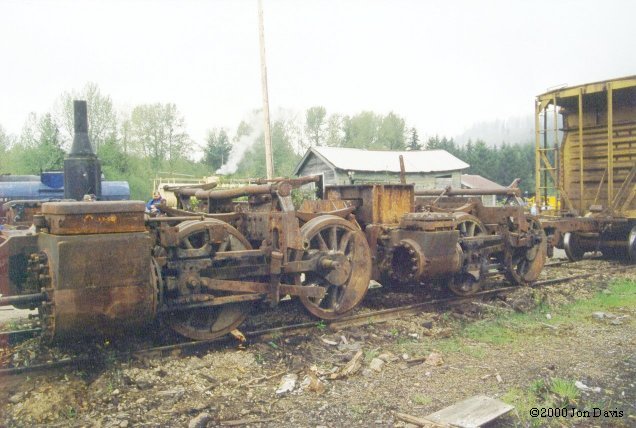

Much like in the story, the #8 started out as a pair of used Dinkies. I used the motor blocks and cylinders from a 20 year old LGB 2017, and a similar vintage 2020. These were 0-4-0s not 0-4-2s as stated in the story, but I needed a plausible source for the pilot and trailing trucks.
The boiler and much of the superstructure were constructed from new-old-stock Delton C-16 (2-8-0) parts. Many, many small detail castings were purchased from Ozark Miniatures and Trackside Details.
Technically the model
is a Meyer, not a Mallet because both motor blocks are articulated.
This was done to allow it to negotiate sharper curves. The tender is
from a recent era LGB 2-4-0
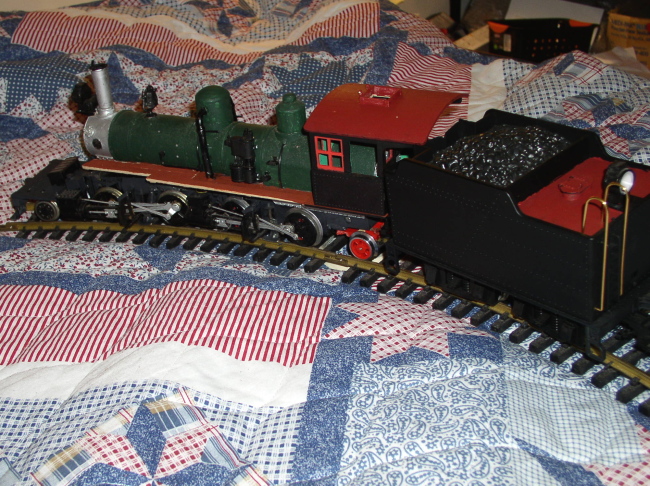
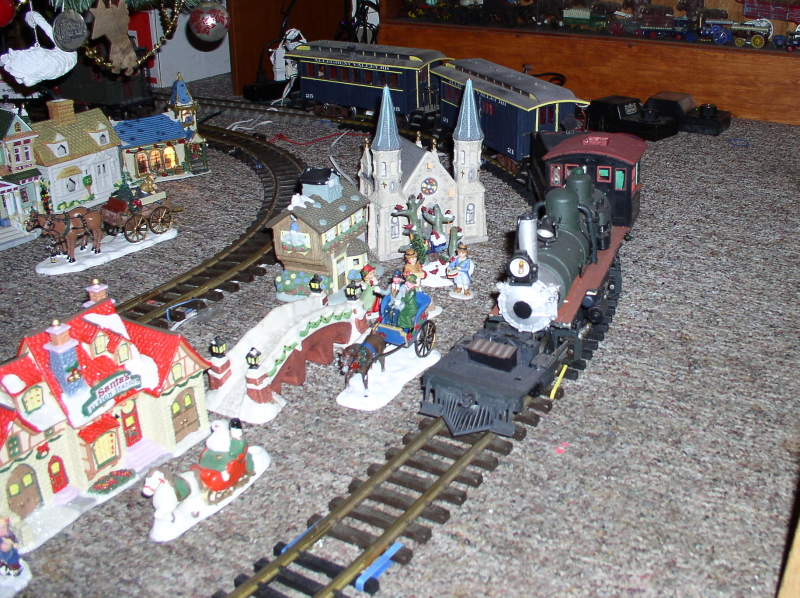

The partially completed locomotive was extensively tested for 3 weeks under the Christmas tree...
All the piping had to be bent by hand from wire. The cross compound air pump was scratchbuilt from two single pumps.
A move created much delay in finishing
the model, much like the wartime rationing in the story. The completion
date was not until May 24, 2010. It needs to be lightly weathered and a
more realistic coal load added.. Yes, those are Karl's elk antlers on
the headlight. I found them in a dollhouse store
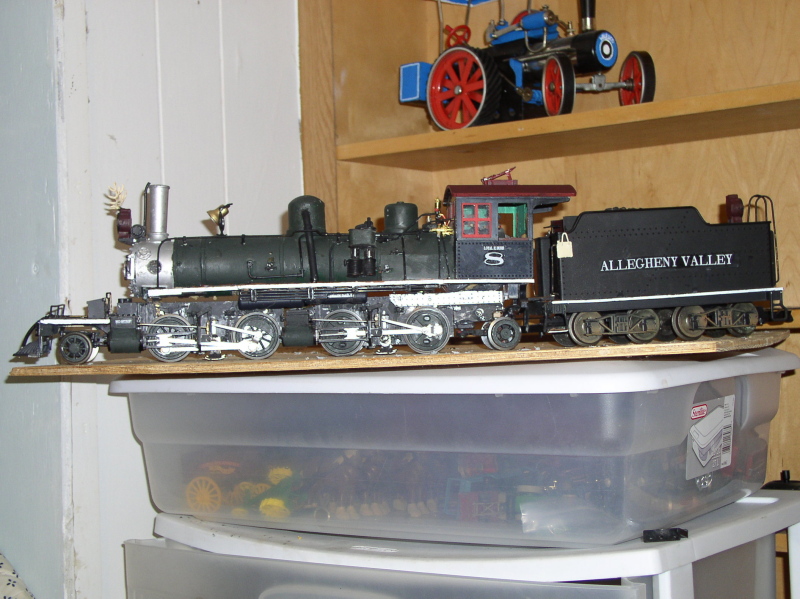
And what about all
those gentlemen mentioned in the story? They were real people. Loyal
Ernest (Chuck) Burr was my maternal grandfather. He actually worked for
the Baltimore and Ohio RR in maintenance of way. His father's name was
Charles. My mother's other grandfather was named Carl Brandstetter, he
worked as a janitor in a mill, but got a promotion for the story.
Daniel Marsh Sinclair and Harry Allen were my other grandmother's
grandfathers. Now you know the rest of the story.